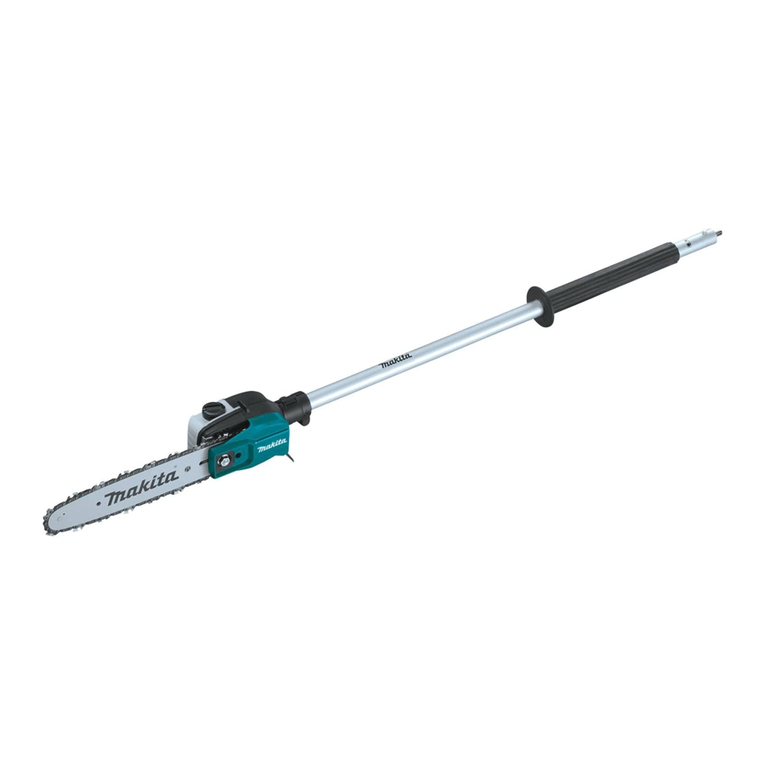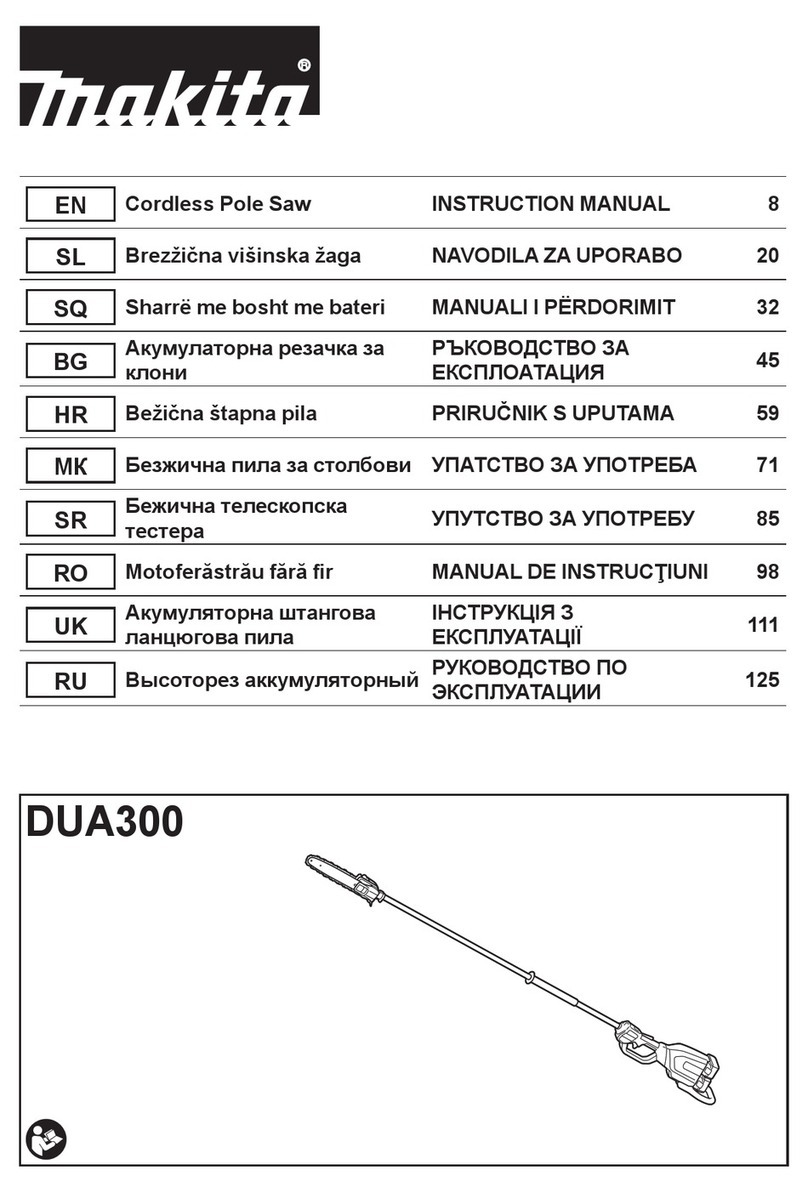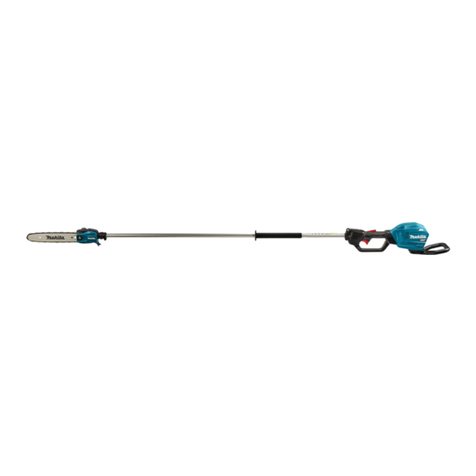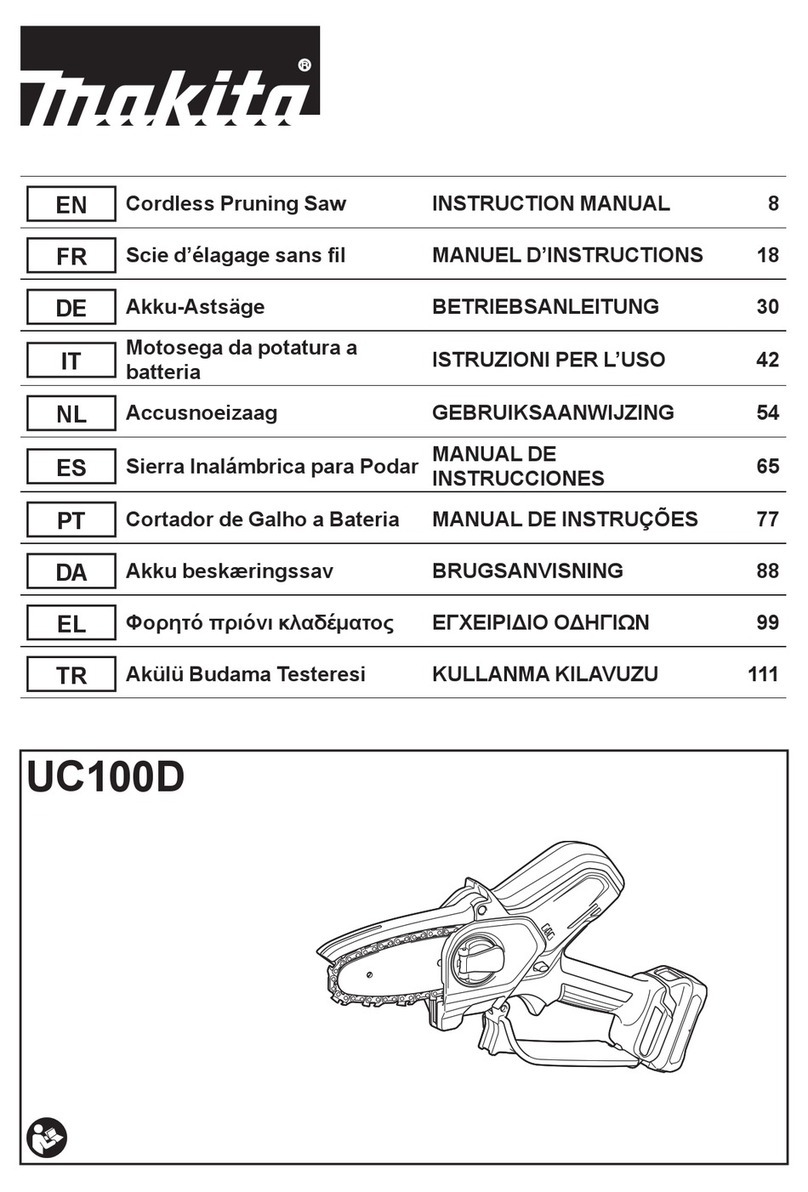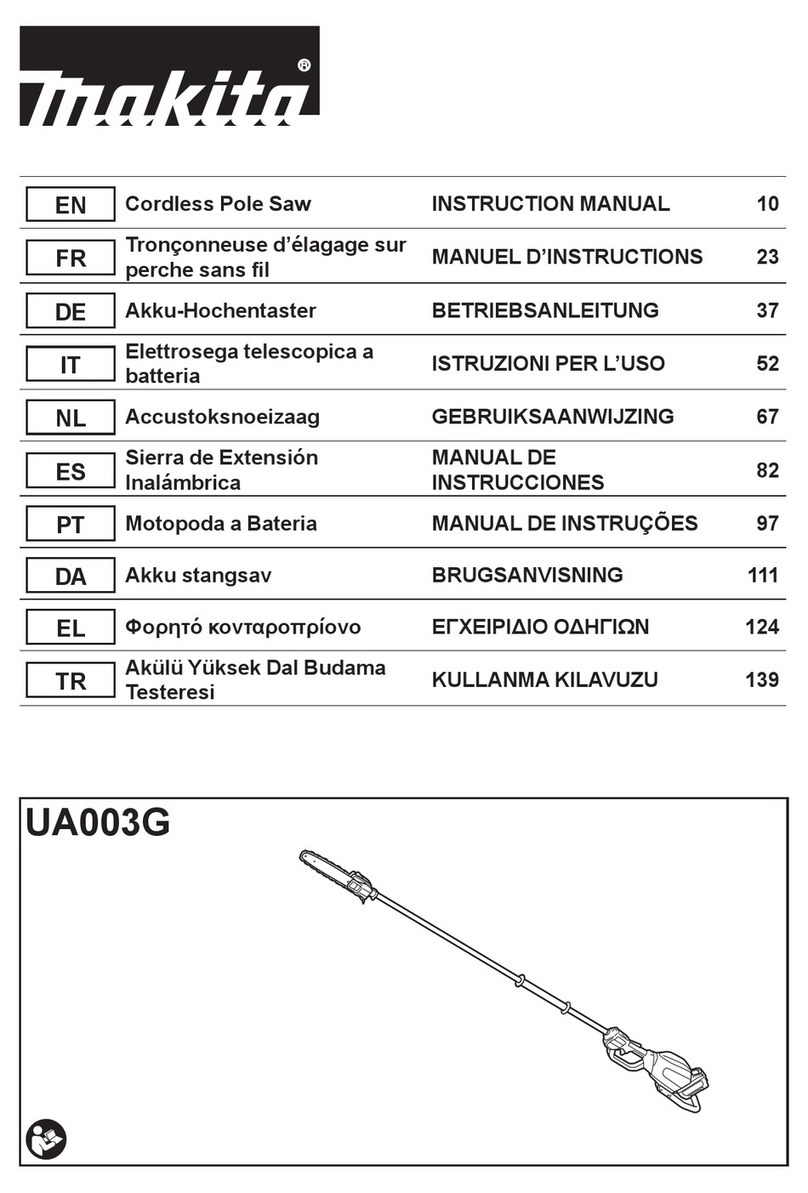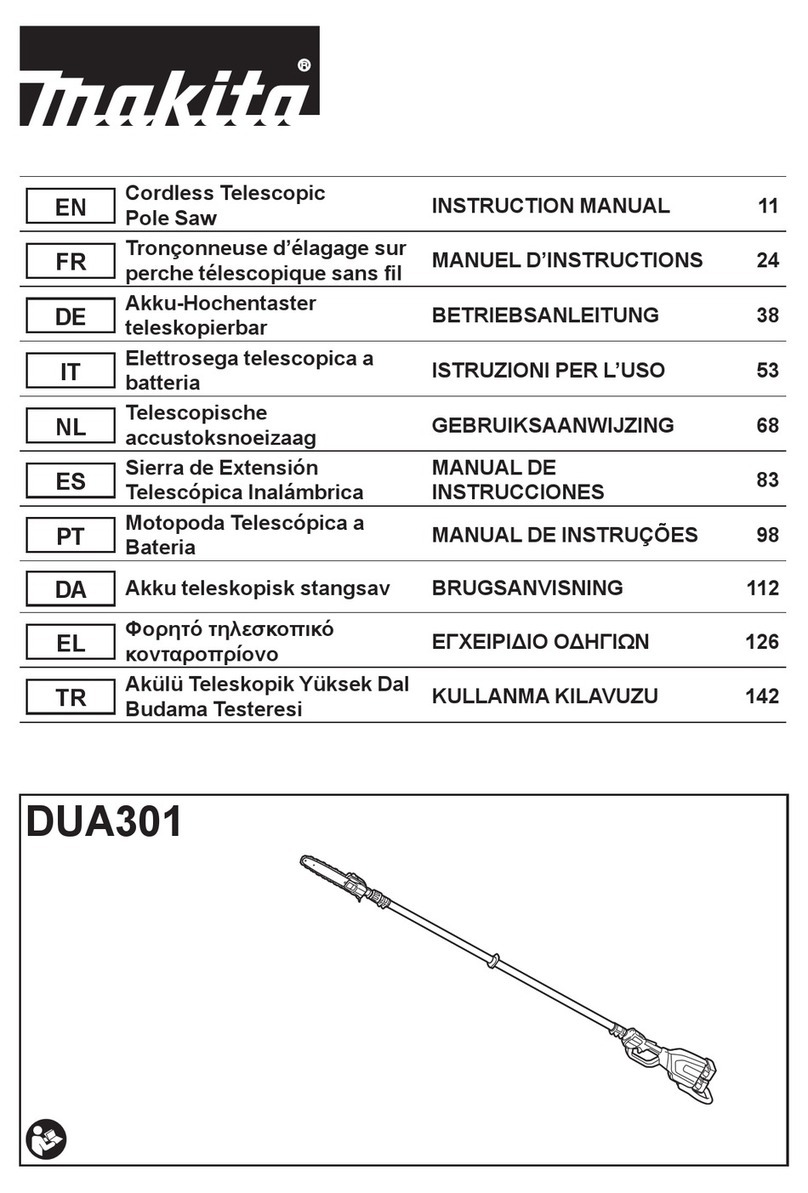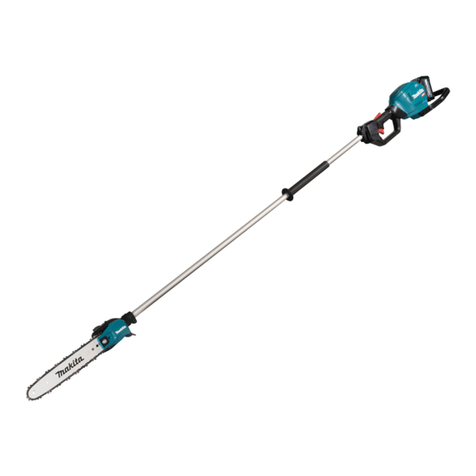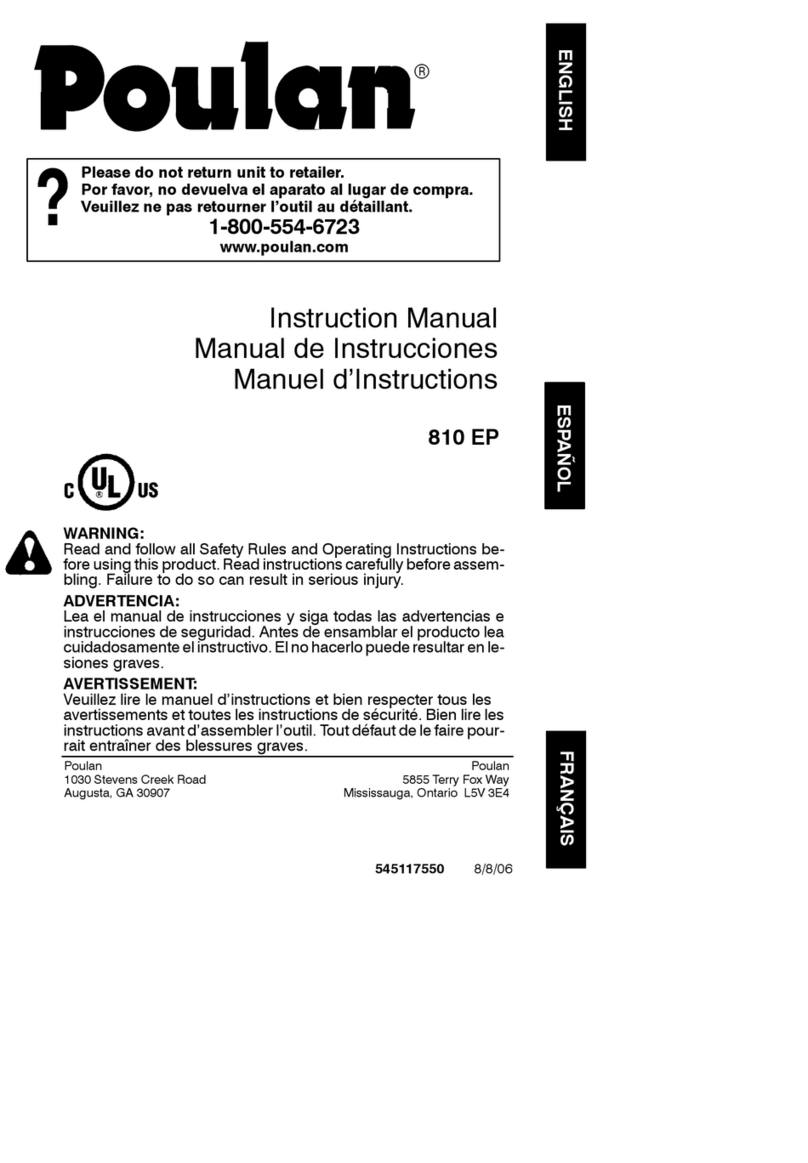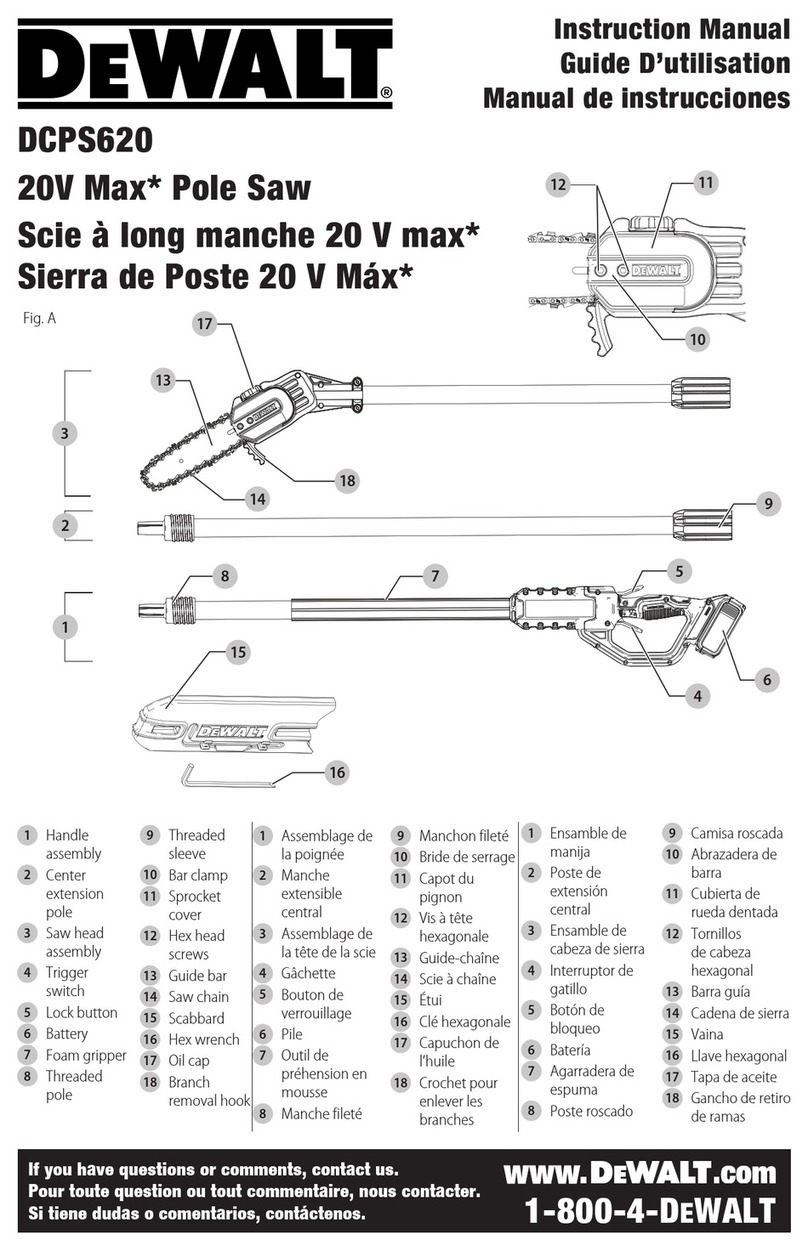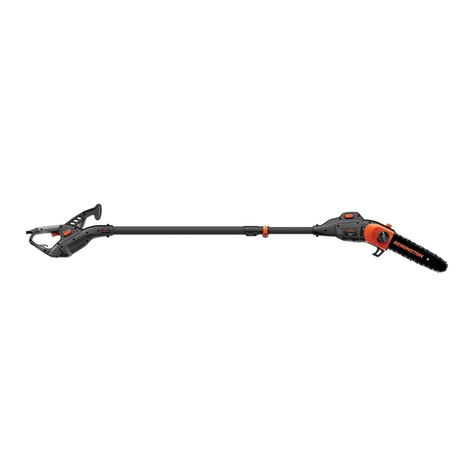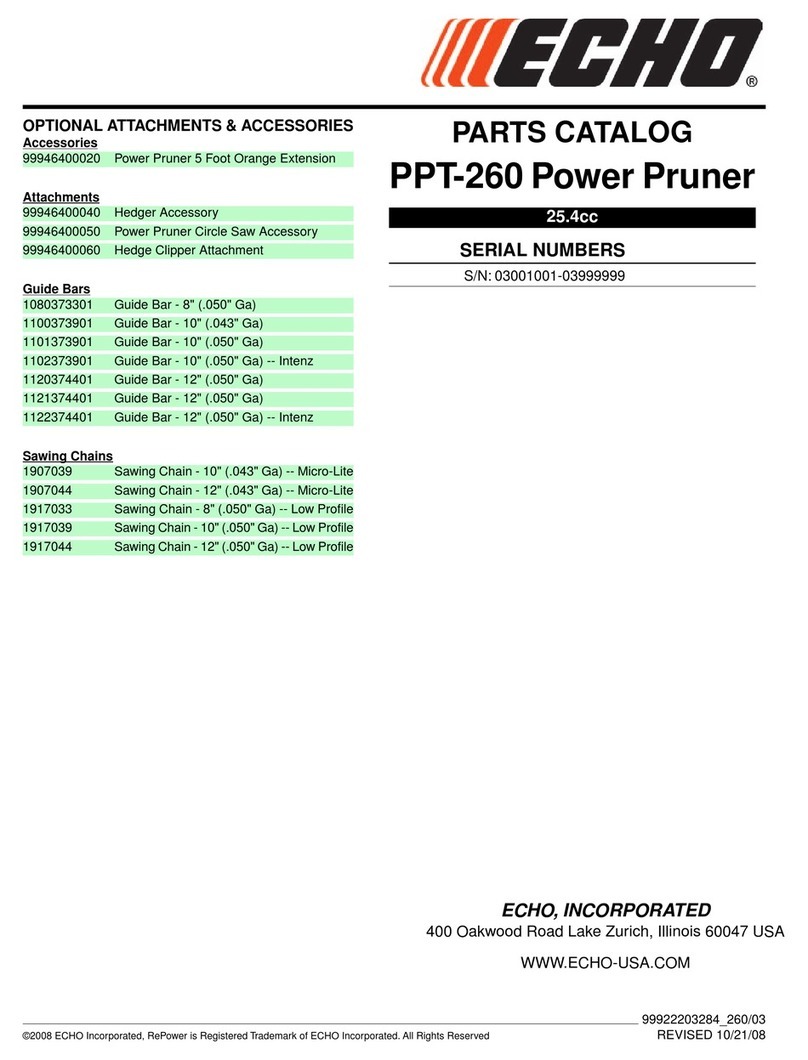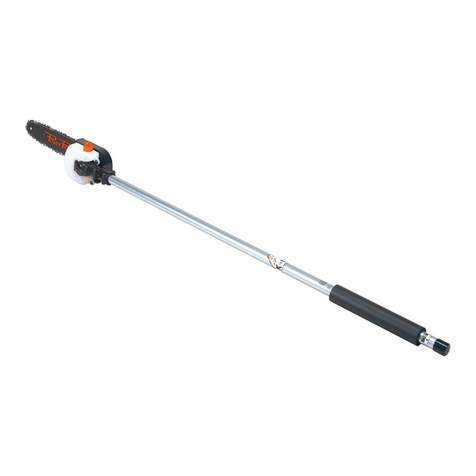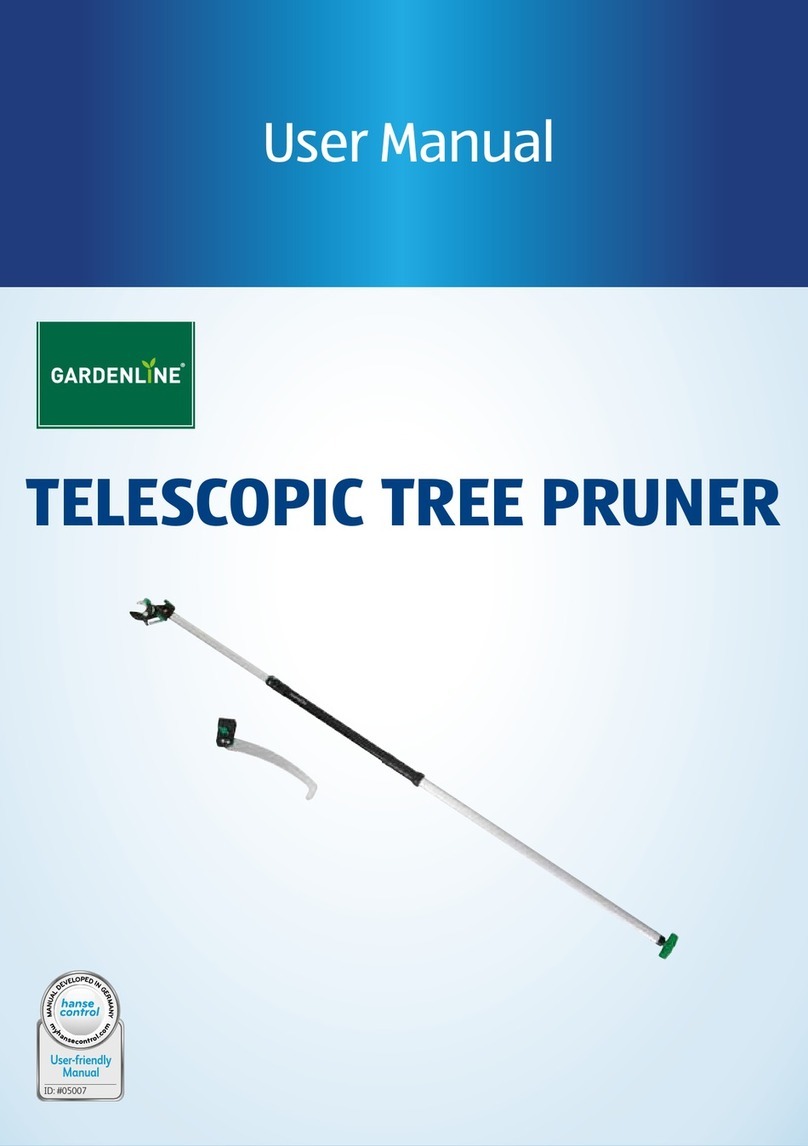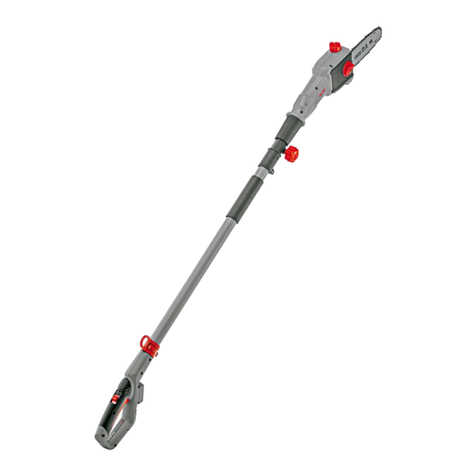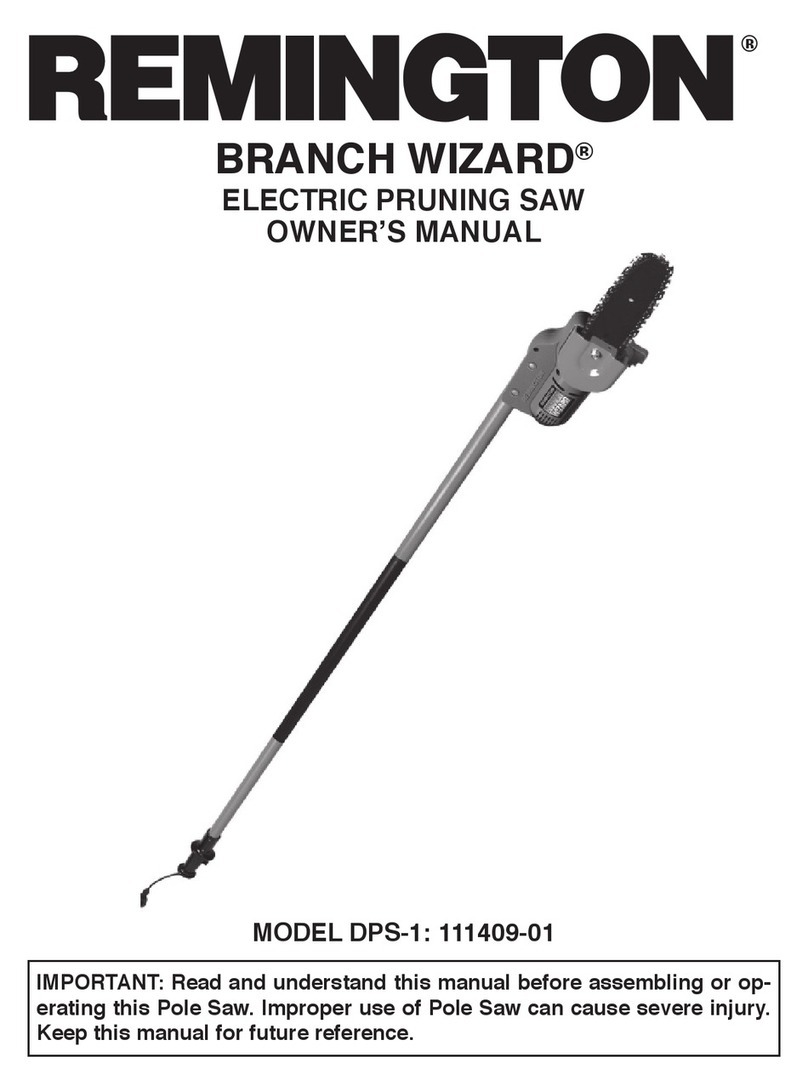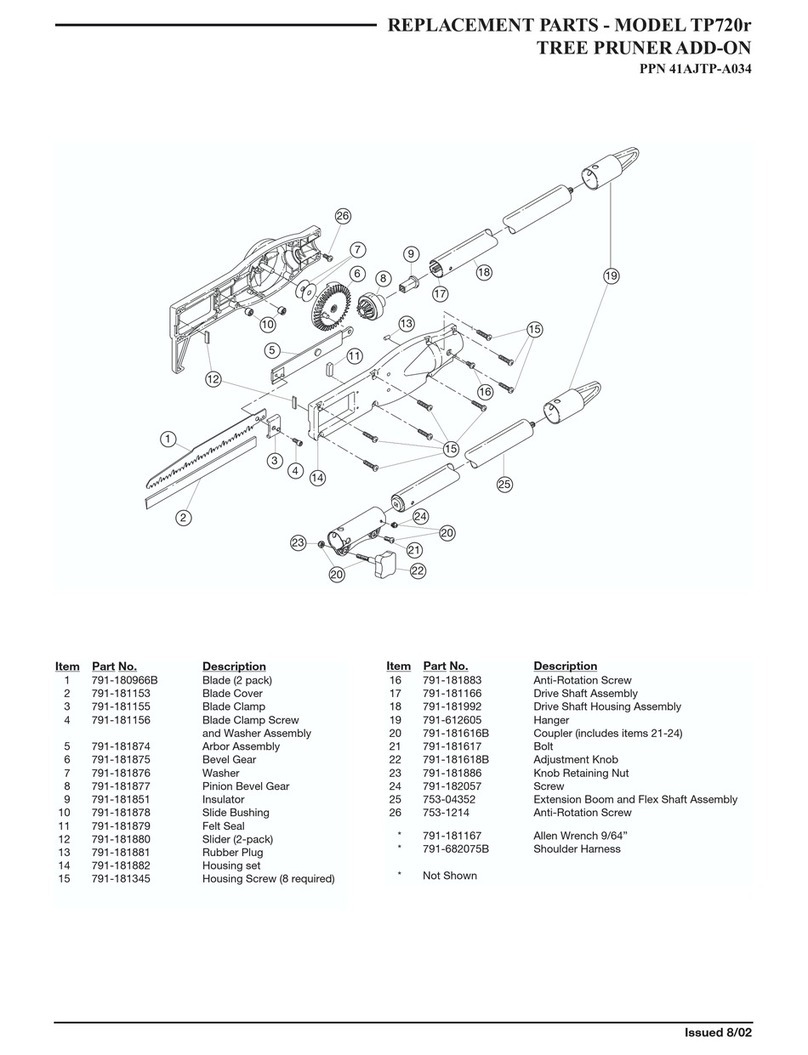7
ditches to avoid stumbling. Clear fallen branches and other
objects away.
Never work on a ladder or tree to avoid loss of control.•
If the equipment gets heavy impact or fall, check the condition•
before continuing work. Check the fuel system for fuel leakage
and the controls and safety devices for malfunction. If there is
any damage or doubt, ask Makita authorized service center for
the inspection and repair.
Do not touch the gear case. The gear case becomes hot during•
operation.
Take a rest to prevent loss of control caused by fatigue. We•
recommend to take a 10 to 20-minute rest every hour.
When you leave the equipment, even if it is a short time, always•
switch off the engine or remove the battery cartridge. The
equipment unattended with the engine running may be used by
unauthorized person and cause serious accident.
Follow the instruction manual of the power unit for proper use of•
the control lever and switch.
Pay attention to the environment. Avoid unnecessary throttle•
operation for less pollution and noise emissions. Adjust the
carburetor correctly.
During or after operation, do not put the hot equipment onto dry•
grass or combustible materials.
Do not hold your right hand above shoulder height.•
During operation, never hit the saw chain against hard obstacles•
such stones and nails. Take particular care when cutting
branches next to walls, wire fences or the like.
If branches get caught in the attachment, always stop the motor•
and remove the spark plug cap or battery cartridge. Otherwise
unintentional start may cause serious injury.
If the saw chain becomes clogged, always switch off the motor•
and remove the spark plug cap or battery cartridge before
cleaning.
Accelerating the motor with the saw chain blocked increases the•
load and will damage the motor and/or clutch.
Before cutting limbs, keep an escape area away from the falling•
limb. First, clear obstructs such as limbs and branches from the
work area. Move all tools and goods from the escape area to
another safe place.
Before cutting branches and limbs, check the falling direction of•
them, considering the condition of branches and limbs, adjoining
trees, wind direction, etc. Pay full attention to the falling direction,
and the rebound of the branch, which hit the ground.
• Never hold the pole saw at an angle of more than 60°.
Otherwise falling objects can hit the operator and cause
serious injury. Never stand underneath the limb being cut.
Pay attention to broken or bent branches. They may bounce back•
in cutting, causing unexpected injury.
Before cutting limbs that you intend to cut, remove branches and•
leaves around them. Otherwise the saw may be caught by them.
To prevent the saw from being caught in the kerf, do not release•
the throttle lever before pulling the saw out of the kerf.
If the saw chain is bound in the kerf, immediately stop the motor,•
carefully move the branch to open the kerf and release the saw.
Avoid kickback (rotational reactive force towards the operator).•
To prevent kickback, never use the guide bar nose or perform a
penetrating cut. Always beware of the position of the guide bar
nose.
Check the chain tension frequently. When checking or adjusting•
the chain tension, switch off the motor and remove the spark plug
cap or battery cartridge. If the tension is loose, tighten it.
Vibration
People with poor circulation who are exposed to excessive•
vibration may experience injury to blood vessels or the nervous
system. Vibration may cause the following symptoms to occur in
the ngers, hands or wrists: “Falling asleep” (numbness), tingling,
pain, stabbing sensation, alteration of skin color or of the skin. If
any of these symptoms occur, see a physician!
To reduce the risk of “white nger disease”, keep your hands •
warm during operation and well maintain the equipment and
accessories.
Transport
Before transporting the equipment, switch off the motor and•
remove the spark plug cap or battery cartridge. Always t the
guide bar cover during transportation.
When transporting the equipment, carry it in a horizontal position•
by holding the shaft. Keep the hot mufer away from your body.
When transporting the equipment in a vehicle, properly secure•
it to avoid turnover. Otherwise fuel spillage and damage to the
equipment and other baggage may result.
Maintenance
Have your equipment serviced by our authorized service center,•
always using only genuine replacement parts. Incorrect repair
and poor maintenance can shorten the life of the equipment and
increase the risk of accidents.
Before doing any maintenance or repair work or cleaning the•
equipment, always switch off the motor and remove the spark
plug cap or the battery cartridge. Wait until the motor gets cold.
To reduce the risk of re, never service the equipment in the •
vicinity of re.
Always wear protective gloves when handling the saw chain.•
Always clean dust and dirt off the equipment. Never use gasoline,•
benzine, thinner, alcohol or the like for the purpose. Discoloration,
deformation or cracks of the plastic components may result.
After each use, tighten all screws and nuts, except for adjustment•
screws.
Keep the saw chain sharp. If the saw chain has become blunt•
and cutting performance is poor, ask Makita authorized service
center to sharpen it or replace it with new one.
Do not attempt any maintenance or repair not described in this•
booklet or the instruction manual of the power unit. Ask Makita
authorized service center for such work.
Always use Makita genuine spare parts and accessories only.•
Using parts or accessories supplied by a third party may result
in the equipment breakdown, property damage and/or serious
injury.
Request Makita authorized service center to inspect and maintain•
the equipment at regular interval.
Storage
Before storing the equipment, perform full cleaning and•
maintenance. Fit the guide bar cover. Remove the spark plug
cap or the battery cartridge. Drain the fuel and chain oil after the
engine gets cold.
Store the equipment in a dry and high or locked location out of•
reach of children.
Do not prop the equipment against something, such as a wall.•
Otherwise it may fall suddenly and cause an injury.
First aid
• Always have a rst-aid kit close by. Immediately replace
any item taken from the rst aid kit.
When asking for help, give the following information:•
Place of the accident–
What happened–
Number of injured persons–
Nature of the injury–
Your name–
Assembly and adjustment
WARNING:
Before assembling or adjusting the equipment, switch off the•
engine and remove the spark plug cap or the battery cartridge.
Otherwise the saw chain or other parts may move and result in
serious injury.
Before handling the saw chain or adjusting the chain tension,•
wear protective gloves. Otherwise the saw chain can cut bare
hands severely.
When assembling or adjusting the equipment, always put it down.•
Assembling or adjusting the equipment in an upright position may
result in serious injury.
Follow the warnings and precautions in the chapter “Safety•
precautions” and the instruction manual of the power unit.
Assembling the attachment (Fig. 5)
Assemble the attachment as the following steps.
1. Loosen the screw (A) and (B).
2. Insert the shaft into the gear case. Make sure that the pin (D) is
on the upside. If it is difcult to fully insert it, turn the drive axle
(C) manually.
3. Adjust the position of the hole on the shaft to the screw hole (B).
4. Tighten the screw (B) rst and then tighten the screw (A).


